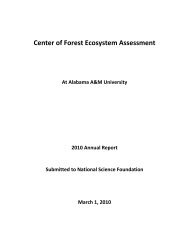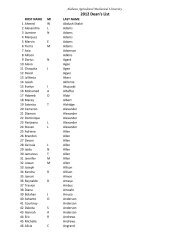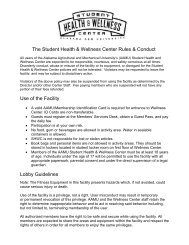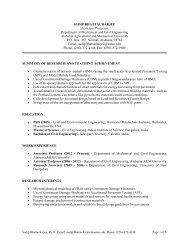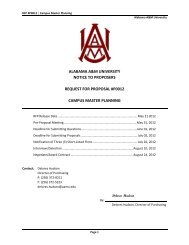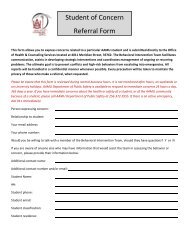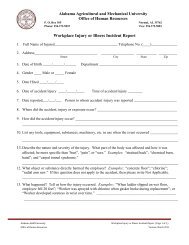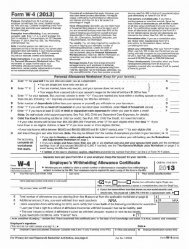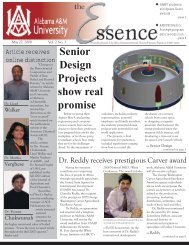This objective is scheduled to be assessed in years 3 through 5.Other Sub-project III Research Activities not Related to Specific ObjectivesIn addition to the research components described in detail in the report, we have been working on thefollowing projects CFEA related research objectives.1. Invasion of a Mined Landscape: what habitat characteristics are influencing theoccurrence of invasive plants?D. Lemke, C. Schweitzer, I. Tazisong, Y. Wang, and J. BrownUsing the Shale Hills region of <strong>Alabama</strong> as a case study, we examined the environmental and habitatfactors that may contribute to favorable conditions for heightened plant invasion, and developedmodels for predicting the probability of occurrence of invasive plant species. We conductedvegetation surveys, soil sampling, and environmental evaluation on the mined landscape.2. Geospatial Assessment of Non-native Vegetation: application of geospatial models topredicting alien plants on reclaimed mines in the Shale Hills regionD. Lemke, C. Schweitzer, W. Tadesse, Y. Wang, J. BrownUsing the Shale Hills region of <strong>Alabama</strong> as a case study, we examined the environmental and habitatfactors that may contribute to favorable conditions for heightened plant invasion, and developedmodels for predicting the probability of occurrence of invasive plant species. We conductedvegetation surveys, soil sampling, and environmental evaluation on the mined landscape.3. Habitat Modeling of Alien Plant Species at Varying Levels of Occupancy in the CumberlandPlateauD. Lemke, P. Hulme, J. BrownWe assess predictive habitat models for three invasive plant species, at differing level of occurrenceutilizing two different habitat-modeling techniques, logistic regression and maximum entropy. Theinfluence of disturbance, spatial and temporal heterogeneity and other landscape characteristics areassessed by creating regional level models based on occurrence records from the United StatesDepartment of Agriculture, Forest Service, Forest Inventory and Analysis database. Logisticregression and maximum entropy (MaxEnt) models were assessed independently and evaluated aspredictive tools to test the value of presence/absence and presence only data in predicting speciesdistributions. Ensemble models were also developed that combined the predictions of the twomodeling approaches to obtain a more robust prediction estimate.
4. Invasive Potential of Five Alien Trees in the Forest of the Southern Region, United StatesD. Lemke, P. Hulme, J. Brown, J. Miller, J. CoulstonIn the southern region of the United States invasive plants are one of the threats to the long termsustainability of our forest ecosystems, along with climate and land use change. We assessed thepotential distribution of five alien trees in the southern region on forested lands. Maximum entropyalgorithms were used to integrate anthropogenic and environmental variables with speciesoccurrence data from the USDA Forest Service. All five species were predicted to significantlyincrease their distribution at the regional level under current conditions. Four climate changescenarios were then applied to the current potential with the five species responded exceedinglydifferent to the future scenario, particularly when climate variables had higher variability betweencurrent conditions and future scenarios.5. Value of Systematic Versus Opportunistic Data for Species Distribution Modeling: casestudy of five invasive trees in the southern United StatesD. Lemke, P. Hulme, J. Brown, J. Miller, J. CoulstonInvasive species are one of the fundamental ecological challenges we are currently facing.Knowledge is the best tool in this battle, in not only determining which species will become the mostdetrimental but where they will have the greatest negative impact. One tool that is available toassist in this fight is species distribution models (SDMs). SDMs make predictions about unsampledlocations using the relationships between species and environmental parameters. They are designedto make use of known information of species that are at equilibrium with the environment, andwork best when a full range of the environment has been sampled. However, they have also shownpromise for the study of invasive species, species that have yet to reach equilibrium, or not fullysampled. In this chapter we assess the applicability of different types of datasets to modeling fiveinvasive trees with forests of the southern United States. We used intensively collected systematicabsence/presence data (Forest Inventory and Analysis, FIA), occurrence only, opportunistic data(Global Biodiversity Information Facility, GBIF), and combined datasets.INTERNATIONAL RESEARCH AND EXCHANGENatural resources in GuyanaR. Fraser, D. Singh, H. Alam, L. Carrington, P. ChesneyThis involved four activities: A facilitated discussion of field-training needs in the natural resourcessector in Guyana, Draft and submit 8 proposals to study Mangrove restoration efforts in Guyana, Leadstakeholder discussion and develop the terms of reference for an International Biodiversity Centre, and6 nation dialogue on natural resource conservation and management of the Guyana.
- Page 4 and 5:
Annual Report: 1036600meeting (Octo
- Page 6 and 7:
Annual Report: 1036600collection, a
- Page 8 and 9:
Name: Li, JianqiangWorked for more
- Page 10 and 11:
Annual Report: 1036600Meeting, Fall
- Page 12 and 13:
Annual Report: 1036600Advisor: Dr.
- Page 14 and 15:
Annual Report: 1036600Contribution
- Page 16 and 17:
Annual Report: 1036600including lig
- Page 18 and 19:
and Sea Grant National Water Confer
- Page 20 and 21:
graduate in the Spring of 2013.Name
- Page 22 and 23:
Annual Report: 1036600Name: Jacobs,
- Page 24 and 25:
Annual Report: 1036600Worked for mo
- Page 26 and 27:
Name: Creely, KevinWorked for more
- Page 28 and 29:
Name: Cox, KaysieWorked for more th
- Page 30 and 31:
Annual Report: 1036600Ms. Gresham t
- Page 32 and 33:
Annual Report: 1036600Home Institut
- Page 34 and 35:
Annual Report: 1036600Additionally
- Page 36 and 37:
Annual Report: 1036600silvicultural
- Page 38 and 39:
Annual Report: 1036600Alabama Coope
- Page 40 and 41:
Annual Report: 1036600functionality
- Page 42 and 43:
Annual Report: 1036600C. Kenneth Do
- Page 44 and 45:
Annual Report: 1036600U.S. Army Eng
- Page 46 and 47:
Annual Report: 1036600graduate stud
- Page 48 and 49:
Annual Report: 1036600Nyakatawa's r
- Page 50 and 51:
Annual Report: 1036600FACULTY TRAIN
- Page 52 and 53:
Annual Report: 1036600general fores
- Page 54 and 55:
Annual Report: 1036600implementatio
- Page 56 and 57:
Annual Report: 1036600Science, Tech
- Page 58 and 59:
Annual Report: 1036600Indumathi Kam
- Page 60 and 61:
Annual Report: 1036600James H. Mill
- Page 62 and 63:
Annual Report: 1036600Stringer, B.,
- Page 64 and 65:
Annual Report: 1036600Daniel C. Dey
- Page 66 and 67:
Annual Report: 1036600traditionally
- Page 68 and 69:
Annual Report: 1036600variables, bo
- Page 70 and 71:
Annual Report: 1036600Our students
- Page 72 and 73:
Annual Report: 1036600showed that f
- Page 74 and 75:
RESEARCH FINDINGS 2012The Center fo
- Page 76 and 77:
urn-only stands did not decrease po
- Page 78 and 79:
1.2 Herpetofaunal and Small Mammal
- Page 80 and 81:
3. Determine the change of territor
- Page 82 and 83:
1000 bp500 bp200 bpWe examined cros
- Page 84 and 85: Bush honeysuckle. After two growing
- Page 86 and 87: Royal paulownia. The mortality data
- Page 88 and 89: 2. Relationship between forest dive
- Page 90 and 91: 3. Determine the effects of urban a
- Page 92 and 93: 800NH 4+ -N Released (ug g-1 )60040
- Page 94 and 95: Table 5. Microbial indices at treat
- Page 96 and 97: 0.60-10 cmB 0T 0 - No burn, No thin
- Page 98 and 99: effect on significantly changing th
- Page 100 and 101: Findings to be presented in year 3
- Page 102 and 103: 1. Extend the land cover change geo
- Page 104 and 105: ates and type II errors, suggesting
- Page 106 and 107: suggested between two to four times
- Page 108 and 109: 1. Poster presentation (Emily Summe
- Page 110 and 111: 6. Poster presentation (Douglas Was
- Page 112 and 113: Attendees from AAMU and affiliates:
- Page 114 and 115: This was done both when the stand w
- Page 116 and 117: wildlife response to various distur
- Page 118 and 119: Purdue University to use as a contr
- Page 120 and 121: as a threat to biodiversity of impe
- Page 122 and 123: changes in the riparian and aquatic
- Page 124 and 125: phosphatases and phytase were deter
- Page 126 and 127: Figure 2. Schematic diagram of the
- Page 128 and 129: Eddy Covariance System SensorsSonic
- Page 130 and 131: Plot scale 3-D visualization with a
- Page 132 and 133: 2. Determine the effects of landown
- Page 136 and 137: Alabama A&M University China Exchan
- Page 138 and 139: External Advisory Board MeetingThe
- Page 140: updates and feedback. There were tw



